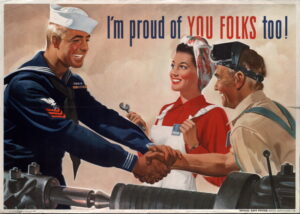What is Training Within Industry
Training Within Industry requires collaboration
The primary idea behind Training Within Industry (TWI) is that it works as an agreement that has been developed through collaboration between supervisors/managers and employees (usually operators, although they could also be customer service specialists, HR staff, engineers, etc.). Training Within Industry is not something that certain individuals develop and then “distribute” to those who are to perform the work.
Definition of Training Within Industry
Training Within Industry is the most reliable, simplest and most loss-free way of performing a job that we are currently aware of. It is developed and owned by operators, team leaders and supervisors who work together, providing a basis for future improvements. It is very flexible, can be changed through Kaizen (change for the better) and can meet the intended production rate due to its changeability. It has to do with working smarter – not harder or faster.
Training Within Industry is not a set of work instructions developed by engineers. Training Within Industry does not focus on standard efficiency and is not bound to cost reporting and product calculations.
History
When the USA prepared to enter World War II, the country was already an important supplier of war equipment to the Allied powers (the United Kingdom, France and even the Soviet Union). The USA needed to quickly increase its industrial production at the same time that the industrial labour force was being mobilised to take part in the war. Individuals who were not mobilised (in particular women) were employed in production, but they had no experience of industrial work, which is why the TWI (Training Within Industry) method was developed.
After World War II, Japanese companies such as Datsun, Toyota, Yamaha, Sanyo and Mitsubishi developed Training Within Industry as a cornerstone of Lean production. The method was further developed over the years, resulting in a corporate culture that came to be known as “the Japanese miracle” during the 1970s and thereafter, when the products from these companies outclassed everything else in the world.
What many people don’t know is that the Japanese received extensive support and training after the war from those responsible for developing the American war industry to the top level, including with the help of the TWI method.
Examples of advertising posters used by the United States Department of War during the 1940s:
 |
 |
Measures for standardized work
Standardized work is successful when it drives the organization to Kaizen, (change for the better). A mentor told me: – If your standardized work hasn’t changed in three to six months, it’s not standardized work. You should always strive to improve.
It allows an organization to capture small changes between operators, so that everyone can learn and benefit. In this way, it helps the business to capture the professional knowledge that so many people struggle to obtain.
It works as a diagnostic function. With standardized work, operators can analyze their work and identify which steps they can´t perform according to the current standard. This gives them the opportunity to ask for help rather than explaining poor results.
Standardized work also allows managers to review the process in real time and observe operators as they perform tasks, (it is part of the managers’ standardized work). When a task deviates from the documented process, a leader can determine whether the deviation is more efficient (driving towards Kaizen) or less efficient (driving coaching opportunities).
Standardized work eliminates waste and problems. It gives everyone a chance to see the waste in the process.
The founder of the Toyota Production System, Taiichi Ohno, said: – Without standards, there can be no Kaizen.
If you want to know more about how we at Qestio can help you analyze the savings potential in your production facility and support you in implementing the necessary changes – contact us.
